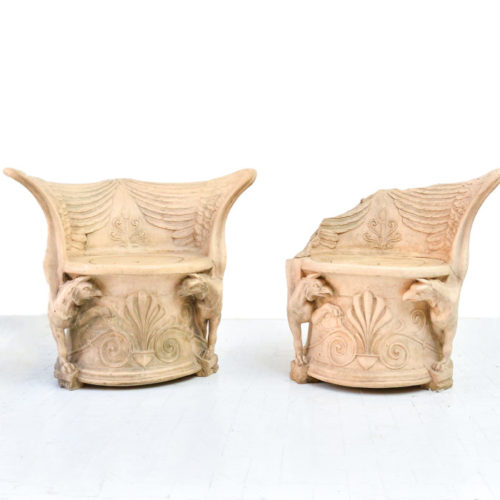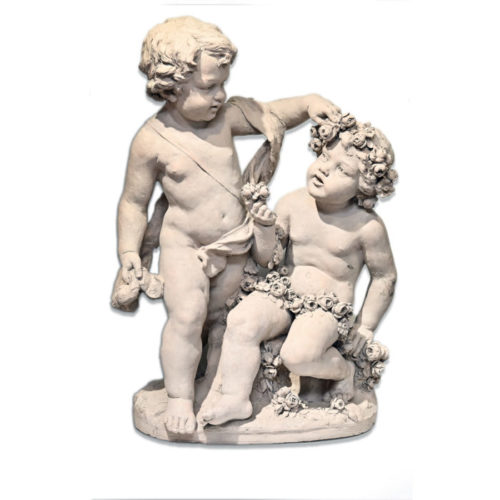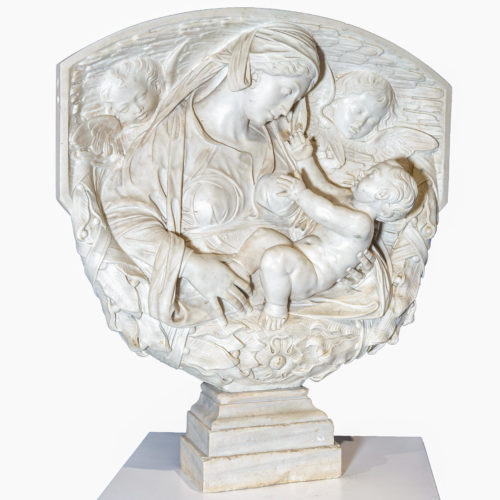-
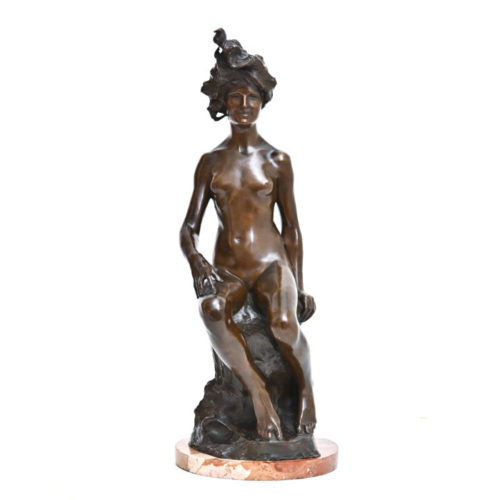 Bronze by Giovanni Nicolini, work of the 1920s / 1930s. Giovanni Nicolini was born in Palermo on April 14, 1872. He died in Rome in 1956. In the 1920s / 1930s the author focused his formal research on the theme of the nude figure, giving life to works strongly expressive of feelings or passions, in which the female figure with floating hair and enveloping shapes revealed a strong art nouveau influence. Period: 1920s / 30s Measurements: H with base 51 cm / H 49 x Ø base 19 cm
Bronze by Giovanni Nicolini, work of the 1920s / 1930s. Giovanni Nicolini was born in Palermo on April 14, 1872. He died in Rome in 1956. In the 1920s / 1930s the author focused his formal research on the theme of the nude figure, giving life to works strongly expressive of feelings or passions, in which the female figure with floating hair and enveloping shapes revealed a strong art nouveau influence. Period: 1920s / 30s Measurements: H with base 51 cm / H 49 x Ø base 19 cm -
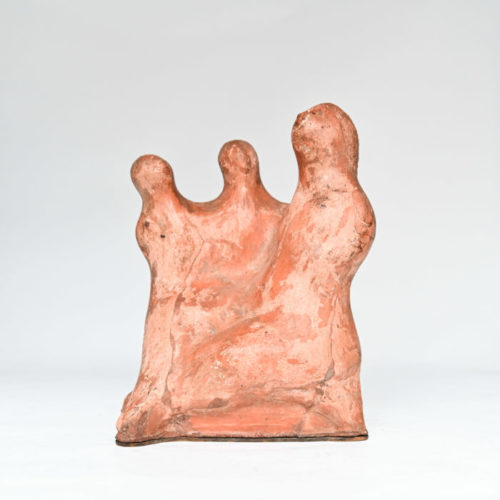 Period: 1949 Measurements: H 35 x W 26 x D 20 cmTerracotta sculpture by Carmelo Cappello (Ragusa, 21 May 1912 - Milan, 21 December 1996) signed and dated 1949. CARMELO CAPPELLO (Ragusa 1912 - Milan 1996) He attended the Comiso School of Art. Trained at a very young age in Ettore Colla's studio, he moved to Milan in the 30th. Thanks to a scholarship he follows the courses of Marino Marini at the Istituto Superiore di Monza. In 37 he made his debut as a sculptor and the following year he held his first solo show at the Bragaglia Gallery in Rome. In 41 he consolidated his friendship with Giò Ponti, which later became a close collaboration. He has participated numerous times in the Venice Biennale, the Rome Quadriennale and the Milan Triennale. In 59 he was invited to Documenta 2 in Kassel. After the first figurative phase, struck by Moore's modern European sculpture, he passes from Tatlin's Russian Constructivism to the discoveries of the filtering space of Pevsner, Brancusi and Gabo: these are the cultural matrices, in his artistic iter, of his original declination of pure linear rhythms and volumetric that constitute the fulcrum of his mature language. Constant components of its structures are the curve, linked in the circle or marked in the ellipsis, in a rigorous equilibrium of two-dimensional relationships. In Ragusa, in 94, the Civic Collection Cappello was inaugurated, the result of the donation of 15 sculptures and 20 graphic works that formed the starting point of the Museum dedicated to him in 55. Good production of multiples and graphics of his maturity.
Period: 1949 Measurements: H 35 x W 26 x D 20 cmTerracotta sculpture by Carmelo Cappello (Ragusa, 21 May 1912 - Milan, 21 December 1996) signed and dated 1949. CARMELO CAPPELLO (Ragusa 1912 - Milan 1996) He attended the Comiso School of Art. Trained at a very young age in Ettore Colla's studio, he moved to Milan in the 30th. Thanks to a scholarship he follows the courses of Marino Marini at the Istituto Superiore di Monza. In 37 he made his debut as a sculptor and the following year he held his first solo show at the Bragaglia Gallery in Rome. In 41 he consolidated his friendship with Giò Ponti, which later became a close collaboration. He has participated numerous times in the Venice Biennale, the Rome Quadriennale and the Milan Triennale. In 59 he was invited to Documenta 2 in Kassel. After the first figurative phase, struck by Moore's modern European sculpture, he passes from Tatlin's Russian Constructivism to the discoveries of the filtering space of Pevsner, Brancusi and Gabo: these are the cultural matrices, in his artistic iter, of his original declination of pure linear rhythms and volumetric that constitute the fulcrum of his mature language. Constant components of its structures are the curve, linked in the circle or marked in the ellipsis, in a rigorous equilibrium of two-dimensional relationships. In Ragusa, in 94, the Civic Collection Cappello was inaugurated, the result of the donation of 15 sculptures and 20 graphic works that formed the starting point of the Museum dedicated to him in 55. Good production of multiples and graphics of his maturity. -
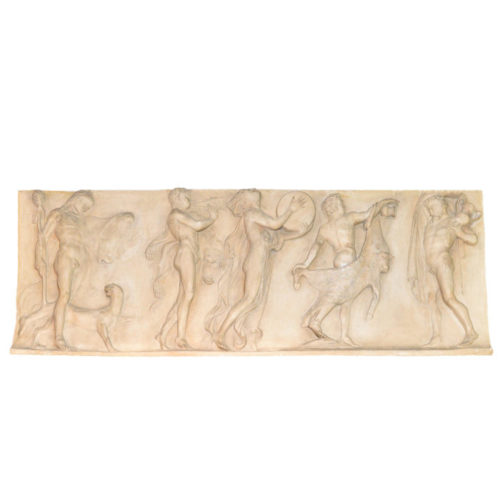 Period: Early 1900s Measurements: H 58 x W 157 x D 10 cmTerracotta panel depicting a classical scene. On the back the Manifattura di Signa brand. In excellent condition. The Manifattura di Signa is a historic terracotta pottery workshop. It was created in 1895 by the will of Camillo Bondi. "At the beginning of the twentieth century Signa was still one of the major industrial centers of straw. To that industry, which had made the name of the town known beyond national borders, was added another activity which, since the last five years of the nineteenth century and in a short space of years, it would have relaunched its name on the European and American markets: the artistic terracotta industry "Manifattura di Signa", founded in Signa (Florence), in 1895 by Camillo Bondi, on the premises of the factory " Fornaci di Signa "owned by his brother Angelo. At that time, the taste for antique fakes continued to seduce with all its charm, and in ceramics the interest in tradition had prompted the most important Italian manufacturers to revisit shapes and decorations Renaissance, reaching the ancient virtuosity of the historiated and grotesques with a high craftsmanship. If those productions interpreted the ancient with typical nineteenth-century eclecticism, the Manifattura di Signa on the other hand, it generated the perfect resemblance of the truth, both through the forms used when possible on the original, and by means of patinas simulating those of marbles and bronzes and even the faults of time, in order to obtain the appearance of the authentic piece, and visually as well as tactile and, in some bronzes, also sound. With this spirit, reproductions of sculptural and decorative masterpieces of all times will take shape from the Arno mud: from Etruscan to Greek statuary, from Roman to Renaissance, from Moorish vases to contemporary Art Nouveau creations. The success that ensued is witnessed by numerous exhibition awards such as the medal at the Universal Expo in Paris in 1900, where he exhibited numerous plastic terracotta, suitable for decorating the exteriors, with a particular patination that made it look better and more resistant to agents. atmospheric, soon expanded the number of occupations and the specialization of young artists assisted by the experience of sculptors of excellent fame, called to Signa for new ideas by the Bondi brothers, the brilliant founders and conductors of the Manufacture, coming from a family of Leghorn Jewish high bourgeoisie and close to the intellectual and anti-positivist environment of the Florentine magazine of “Il Marzocco”. With the new industry an informal school of young workers was thus generated in the Signe who, despite lacking regular education, growing under the experience of sculptors and in contact with the most sublime models of universal classicism, a real concentrate of museums in the world , were naturally stimulated and educated in the beauty and proportions of forms, so much so that they became refined craftsmen, plasticizers, sculptors, able to give life to other similar manufactories. " There are many artists who have collaborated with the Signa Manufacture: Oreste Calzolari, Giovanni Prini, Giulio Cantalamessa, Adolf von Hildebrand, Raffaello Romanelli, Giuseppe Santelli, Renato Bertelli, Giovan Battista Casanova, Bruno Catarzi, Italo Griselli
Period: Early 1900s Measurements: H 58 x W 157 x D 10 cmTerracotta panel depicting a classical scene. On the back the Manifattura di Signa brand. In excellent condition. The Manifattura di Signa is a historic terracotta pottery workshop. It was created in 1895 by the will of Camillo Bondi. "At the beginning of the twentieth century Signa was still one of the major industrial centers of straw. To that industry, which had made the name of the town known beyond national borders, was added another activity which, since the last five years of the nineteenth century and in a short space of years, it would have relaunched its name on the European and American markets: the artistic terracotta industry "Manifattura di Signa", founded in Signa (Florence), in 1895 by Camillo Bondi, on the premises of the factory " Fornaci di Signa "owned by his brother Angelo. At that time, the taste for antique fakes continued to seduce with all its charm, and in ceramics the interest in tradition had prompted the most important Italian manufacturers to revisit shapes and decorations Renaissance, reaching the ancient virtuosity of the historiated and grotesques with a high craftsmanship. If those productions interpreted the ancient with typical nineteenth-century eclecticism, the Manifattura di Signa on the other hand, it generated the perfect resemblance of the truth, both through the forms used when possible on the original, and by means of patinas simulating those of marbles and bronzes and even the faults of time, in order to obtain the appearance of the authentic piece, and visually as well as tactile and, in some bronzes, also sound. With this spirit, reproductions of sculptural and decorative masterpieces of all times will take shape from the Arno mud: from Etruscan to Greek statuary, from Roman to Renaissance, from Moorish vases to contemporary Art Nouveau creations. The success that ensued is witnessed by numerous exhibition awards such as the medal at the Universal Expo in Paris in 1900, where he exhibited numerous plastic terracotta, suitable for decorating the exteriors, with a particular patination that made it look better and more resistant to agents. atmospheric, soon expanded the number of occupations and the specialization of young artists assisted by the experience of sculptors of excellent fame, called to Signa for new ideas by the Bondi brothers, the brilliant founders and conductors of the Manufacture, coming from a family of Leghorn Jewish high bourgeoisie and close to the intellectual and anti-positivist environment of the Florentine magazine of “Il Marzocco”. With the new industry an informal school of young workers was thus generated in the Signe who, despite lacking regular education, growing under the experience of sculptors and in contact with the most sublime models of universal classicism, a real concentrate of museums in the world , were naturally stimulated and educated in the beauty and proportions of forms, so much so that they became refined craftsmen, plasticizers, sculptors, able to give life to other similar manufactories. " There are many artists who have collaborated with the Signa Manufacture: Oreste Calzolari, Giovanni Prini, Giulio Cantalamessa, Adolf von Hildebrand, Raffaello Romanelli, Giuseppe Santelli, Renato Bertelli, Giovan Battista Casanova, Bruno Catarzi, Italo Griselli -
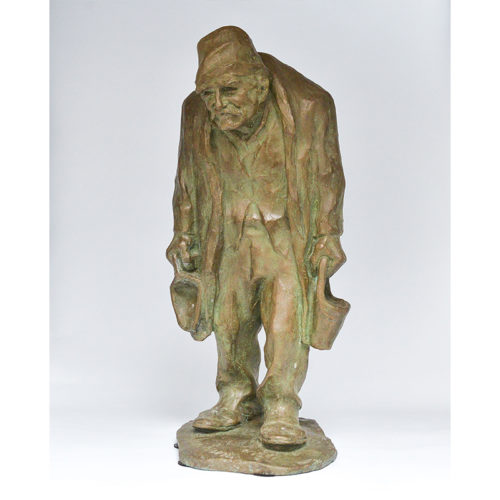 Bronze sculpture by Sandrun entitled "My teacher Tòni dël Fatin". Perfect in patina, excellent condition This work is present in Sandrun's monograph and contains the following description: "His master? Of course" Tòni dël Fatin ", friend of the artist, who died hit by a car right in front of the church of Cossila San Grato, was his teacher. And it was just as the student modeled it in clay and then cast in bronze. An angular, wise, ironic little man, humbled by the weight of years and misery. He had a lot of influence on our Franceschino, especially on the way we relate to the real world, to nature, to men. Like the Greeks , Sandrun also tried to bring out their personality from these figures, not only by working on the face, but also on the body and on the attitudes that life forces us to assume "Period: 1965 Measurements: H 60 x W 35 x D 29 cm
Bronze sculpture by Sandrun entitled "My teacher Tòni dël Fatin". Perfect in patina, excellent condition This work is present in Sandrun's monograph and contains the following description: "His master? Of course" Tòni dël Fatin ", friend of the artist, who died hit by a car right in front of the church of Cossila San Grato, was his teacher. And it was just as the student modeled it in clay and then cast in bronze. An angular, wise, ironic little man, humbled by the weight of years and misery. He had a lot of influence on our Franceschino, especially on the way we relate to the real world, to nature, to men. Like the Greeks , Sandrun also tried to bring out their personality from these figures, not only by working on the face, but also on the body and on the attitudes that life forces us to assume "Period: 1965 Measurements: H 60 x W 35 x D 29 cm -
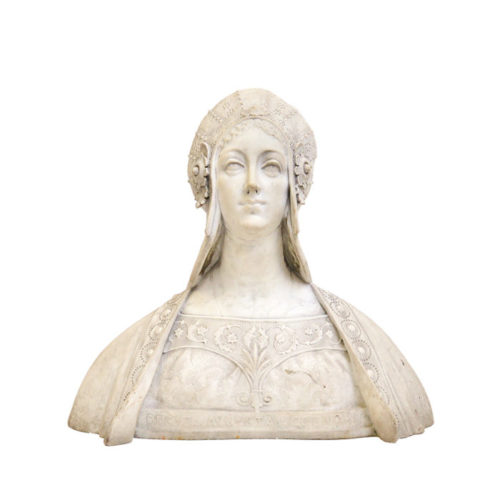 "Florentine noble lady " - Ancient Italian marble from the second half of the 19th century. Tuscan half-bust of exquisite workmanship depicting a noble Florentine lady. Perfectly finished in detail. It bears the inscription"Decus Augusta Coenobili". In good state of conservation and beautiful patina.Period: Second half of the 19th century Measurements: H 66 x W 78 x D 30 cm
"Florentine noble lady " - Ancient Italian marble from the second half of the 19th century. Tuscan half-bust of exquisite workmanship depicting a noble Florentine lady. Perfectly finished in detail. It bears the inscription"Decus Augusta Coenobili". In good state of conservation and beautiful patina.Period: Second half of the 19th century Measurements: H 66 x W 78 x D 30 cm -
Out of stock
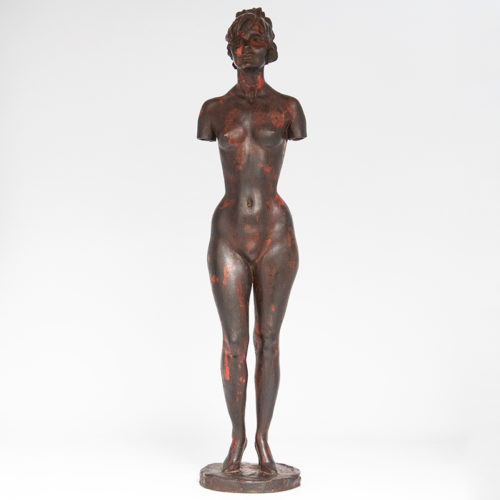 "Donna", unique bronze work by the master Francesco Messina (1900-1995), in dark patina and burgundy shades, authentic from 1990 by the CSD (Milan art center). The master and his art: The artist, Sicilian by birth, trained in Genoa and Milanese by adoption, who was able to experience all the artistic seasons of the 1900s. He has been able to filter and summarize in his works the feeling of time and its passing year after year, work after work, with an always original and coherent look at the poetics of the material. Cocteau said of Messina that "he does not strive to run faster than beauty (...) he walks leaving large footprints on the sand, without the subsequent waves of fashion erasing them". (Cit) Period: 20th century Measurements: H 60 x L 12 x P 8 cm
"Donna", unique bronze work by the master Francesco Messina (1900-1995), in dark patina and burgundy shades, authentic from 1990 by the CSD (Milan art center). The master and his art: The artist, Sicilian by birth, trained in Genoa and Milanese by adoption, who was able to experience all the artistic seasons of the 1900s. He has been able to filter and summarize in his works the feeling of time and its passing year after year, work after work, with an always original and coherent look at the poetics of the material. Cocteau said of Messina that "he does not strive to run faster than beauty (...) he walks leaving large footprints on the sand, without the subsequent waves of fashion erasing them". (Cit) Period: 20th century Measurements: H 60 x L 12 x P 8 cm -
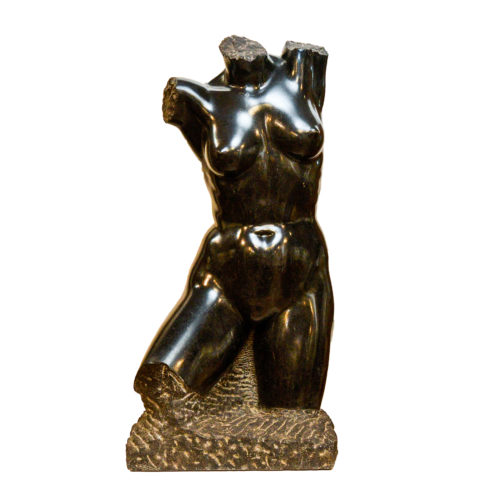 Virgilio Audagna (1903-1995). Born in February 1903 in Cannes, France, where his father and his family had temporarily moved for work. Returning to Italy, he completed his artistic studies and attended the Academy of Fine Arts in Turin. During his artistic career, he has created both large monuments and small-format works. Active not only in Italy but also abroad, where he often stayed, he also had the opportunity to perform models for medals, of sacred and profane subjects, to commemorate numerous events. In addition to being a sculptor, he was a draftsman and painter. He died in Turin in 1994. The work represents a female nude, green marble sculpture.Period: 20th century Measurements: H 94 x W 43 x D 45 cm
Virgilio Audagna (1903-1995). Born in February 1903 in Cannes, France, where his father and his family had temporarily moved for work. Returning to Italy, he completed his artistic studies and attended the Academy of Fine Arts in Turin. During his artistic career, he has created both large monuments and small-format works. Active not only in Italy but also abroad, where he often stayed, he also had the opportunity to perform models for medals, of sacred and profane subjects, to commemorate numerous events. In addition to being a sculptor, he was a draftsman and painter. He died in Turin in 1994. The work represents a female nude, green marble sculpture.Period: 20th century Measurements: H 94 x W 43 x D 45 cm
